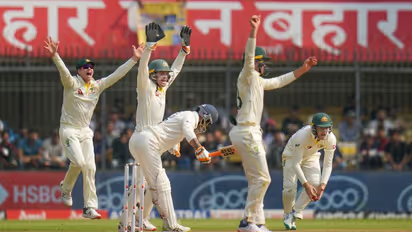IND vs AUS 2022-23, 3rd Test: 'It makes a mockery of Test cricket' - Dilip Vengsarkar critical of Indore track

Synopsis
IND vs AUS 2022-23: India witnessed a batting collapse as the ball began to turn in the opening session on Day 1 of the third Indore Test for the Border-Gavaskar Trophy. Meanwhile, Dilip Vengsarkar was critical of the pitch, terming it a "mockery".
The evil nature of the 22-yard strip at the Holkar Stadium in Indore, where deliveries started turning square from the word go, has reignited the debate of the Indian team dishing out under-prepared surfaces for the ongoing Border-Gavaskar Trophy games against Australia. The ICC match referee Chris Broad is almost sure to take cognisance of the sinister nature of the track, and it won't be surprising that after Nagpur and Delhi, which were rated "average", the pitch for the ongoing Test match could well get a "Below Average" rating.
India was all out for 109 in just over a session, while Australia managed to crawl to 156/4, as 14 wickets fell by the end of the day's play. All teams like to have conditions of their choice at home, but what should be the extent of that home advantage? Another Test is set to be completed within three days. Is that good for the game?
And did the curators get enough time to prepare the surface with the announcement of the game being shifted from Dharamsala only two weeks ago? Could the Board of Control for Cricket in India (BCCI) have managed the last-minute change of venue better? These are some of the lingering questions that deserve an answer.
ALSO READ: 'RAVICHANDRAN ASHWIN IS A FAVOURITE TO GET INTO INDIA'S ALL-TIME XI SQUAD' - RAVI SHASTRI
All the Test matches of the series so far have attracted healthy crowds, but will the fans continue to flock to the venues if the standard of pitches still needs to be addressed? Matthew Kuhnemann had India skipper Rohit Sharma stumped in the sixth over of the game with the ball turning a proverbial mile.
The degree of turn was a massive 8.3. Nathan Lyon got one to dart back in from outside the off stump, keeping the ball low. It left Cheteshwar Pujara surprised. That turned 6.8 degrees. Rohit and Pujara could have used discretion with their shot selection, but having the ball turn at right angles in the first hour left much to be desired. Should the ball have turned that much so early in the game?
Former India captain Dilip Vengsarkar feels the trend of three-day finishes in India makes a mockery of Test cricket. "The pitch makes all the difference if you want to watch good cricket. It would be best to have wickets with even bounce so that both batters and bowlers get equal opportunity. If the ball turns from day one and the first session itself, and that too with uneven bounce, it makes a mockery of Test cricket," Vengsarkar told PTI.
"It is important to get crowds back for Test cricket. You see that in England and Australia, but unfortunately, it is not happening in India. People will come back to Test cricket only if it is interesting. Nobody wants to see bowlers dominating the batters from the first session itself," added one of the finest batters of spin bowling India has produced.
Australian great Matthew Hayden was critical of the Indore pitch and felt sorry for Test cricket fans. "No way spinners should come to bowl in the sixth over. It is why I'm not too fond of these surfaces. It shouldn't be keeping this low and turning so much on Day 1. It doesn't matter whether Australia wins this Test or India. These kinds of surfaces are not good for Test cricket," said Hayden on-air.
The pitch behaved as it did, maybe because it was over-used and the curators needed more time to prepare as the announcement was made in the 11th hour after Himachal Pradesh Cricket Association (HPCA) failed to get its ground ready. The ground has been hosting domestic cricket since September, and only a One-Day International (ODI) was played last month.
"That could also be the reason the bounce is uneven. Curators did not get much time to water and hold the wicket," opined Vengsarkar. A pitch expert who did not wish to be named said it takes at least a month to prepare a good wicket for a Test match. The square houses pitch with red and black soil, but the game is played on the latter.
It is believed that black soil helps in offering more turn and also retains moisture which helps in deviation in the air. "It takes at least a month to prepare a Test wicket. Pitches, too, need rest. In this case, there were not even two weeks between the Ranji Trophy semi-final and this game. Before that, there was an ODI played against New Zealand last month. That seems to have contributed to how the pitch behaves," said an expert in the know of things.
(With inputs from PTI)